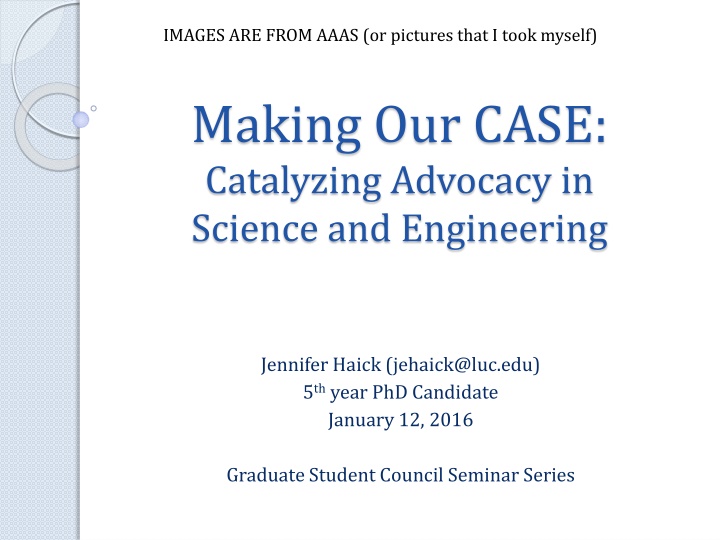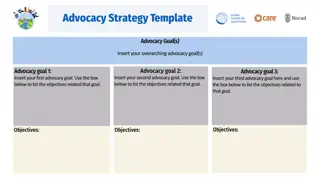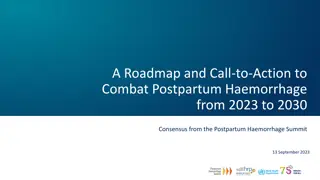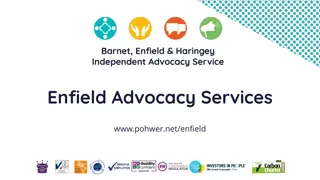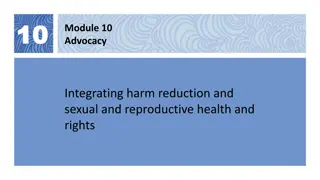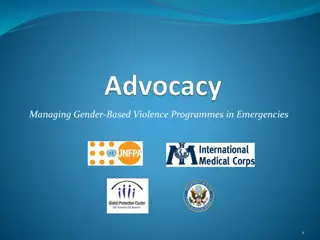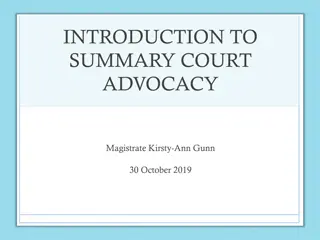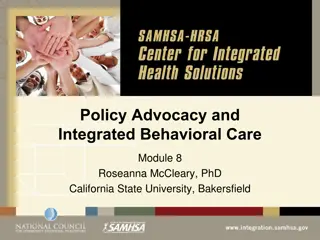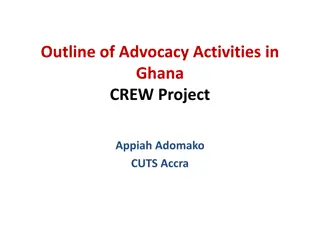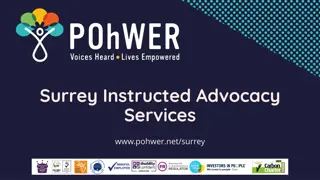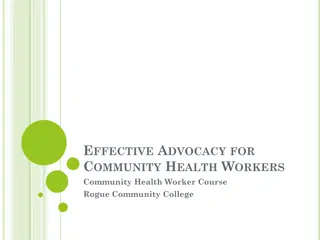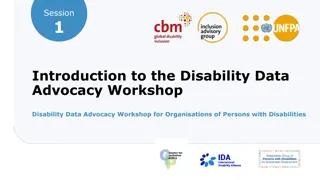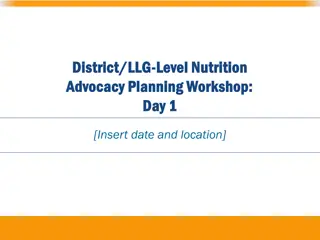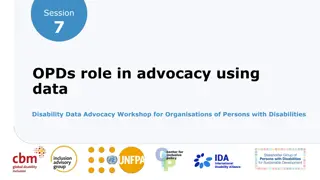Catalyzing Advocacy in Science and Engineering - Workshop Insights
Explore the significance of science policy, federal budget process, and advocacy in science and engineering through workshop insights and practical applications. Gain valuable knowledge on navigating the complexities of science policy, understanding budget allocations, and the role of advocacy in shaping scientific progress. Discover career opportunities in science policy bridging science and public policy domains.
Download Presentation

Please find below an Image/Link to download the presentation.
The content on the website is provided AS IS for your information and personal use only. It may not be sold, licensed, or shared on other websites without obtaining consent from the author.If you encounter any issues during the download, it is possible that the publisher has removed the file from their server.
You are allowed to download the files provided on this website for personal or commercial use, subject to the condition that they are used lawfully. All files are the property of their respective owners.
The content on the website is provided AS IS for your information and personal use only. It may not be sold, licensed, or shared on other websites without obtaining consent from the author.
E N D
Presentation Transcript
IMAGES ARE FROM AAAS (or pictures that I took myself) Making Our CASE: Catalyzing Advocacy in Science and Engineering Jennifer Haick (jehaick@luc.edu) 5thyear PhD Candidate January 12, 2016 Graduate Student Council Seminar Series
Making Our CASE Workshop Hosted by the American Association of the Advancement of Science April 2015 in Washington, D.C. ~100 scientists, mostly graduate students 2 days of workshops, 1 day to meet with members of Congress and their staffers on Capitol Hill
Introduction to Science & Technology Policy Policy for Science: how to fund or structure the pursuit of knowledge Science for Policy: use of knowledge to assist or improve decision making Can be complicated to understand Multiple agencies with unique cultures and missions are overseen by multiple congressional committees Policy can be made at multiple levels (President, Congress, Agency)
Introduction to Science & Technology Policy Understanding and/or participating in science policy is important With a few exceptions, policy makers do not come from a science background Science is difficult to predict and the value may not be immediately known We need to be advocates (but I ll get to that later ) Careers in science policy can vary, but they largely involve acting as a bridge between scientists and the public/policy makers Communication!
Introduction to the Federal Budget Process It's useful to think of the federal budget cycle in four phases Congressional appropriations cycle President s budget formulation Phase 4: Execution of the fiscal year s budget by agencies; begins Oct of FY PHASE 1: Agencies and their offices receive guidance from OMB/OSTP (based on the President s policy preferences) and develop strategic plans, identify priorities and goals, and estimate resources necessary Budget justifications delivered to OMB
Introduction to the Federal Budget Process It's useful to think of the federal budget cycle in four phases Congressional appropriations cycle President s budget formulation Phase 4: Execution of the fiscal year s budget by agencies; begins Oct of FY PHASE 2: OMB thoroughly reviews requests, decides what the Administration will and will not support, and notifies agencies ( passbacks ) Agencies accept or appeal President submits budget to congress
Introduction to the Federal Budget Process It's useful to think of the federal budget cycle in four phases Congressional appropriations cycle President s budget formulation Phase 4: Execution of the fiscal year s budget by agencies; begins Oct of FY PHASE 3: Congress must pass a budget resolution to set framework 12 Appropriations Subcommittees hold hearings, write and eventually pass a spending bill Appropriations Committee passes each spending bill, full chamber amends and approves (House & Senate) A conference committee will work out the differences between the two versions and send a completed bill to the President
Introduction to the Federal Budget Process It's useful to think of the federal budget cycle in four phases Congressional appropriations cycle President s budget formulation Phase 4: Execution of the fiscal year s budget by agencies; begins Oct of FY Note: This is regular order and it hasn t happened since 1996! If the 12 spending bills are not completed, a continuing resolution must be passed to avoid government shutdown until appropriations pass. Funding levels from the previous year are extended, however changes can be made targeting specific programs ( anomalies ). Sometimes multiple continuing resolutions are required.
Introduction to the Federal Budget Process 99% of the budget to fund science falls within discretionary funding Decided by Congress through the appropriations process Good news for FY2016 (omnibus bill passed at the end of December) Funding for science increased across the board
Congress: Structure and Processes Judy Schneider National treasure! Specialist on Congress, Government and Finance Division, Congressional Research Service, Library of Congress Meets with new members of Congress for crash course orientation prior to taking office Congress is not driven by policy alone Politics who the players are, more than the party Procedure how the institution operates Youngest congress in recent history, most of whom have not seen regular order 1 chemist, 1 microbiology, 1 physicist, 1 mathematician, 8 engineers, 25 medical degrees, 213 law degrees
Congress: Structure and Processes Senate Each state gets two representatives Mostly driven by politics Seniority is a major factor in committee assignments, however party control is often irrelevant Unanimous consent can speed procedures along, but a Senator can talk about whatever they want as long as they want (in most cases) House of Representatives Number of representatives per state is based on the state s population Mostly driven by procedure Majority vote needed to bring bill to floor Committee on Rules set specific guidelines for hearings, House members must adhere to rules
Congress: Structure and Processes Each branch has committees Consider, shape and pass//Accept, analyze, amend and pass legislation Standing committees Assigned bills, hold hearings about bills, most bills die in committee Select committees Temporary, for a specific purpose More for an investigation, don t always draft legislation Joint committees Similar to select committees, but members from House and Senate Conference committees Created when the House and Senate need to reconcile different versions of the same bill
Appropriation Subcommittees for Science Energy and Water Department of Energy Forest Service (USDA) Homeland Security Department of Homeland Security Interior and Environment Department of Interior U.S. Fish and Wildlife Service U.S. Geologic Survey Environmental Protection Agency Labor, HHS, Education Department of Education Department of Health and Human Services National Institutes of Health Center for Disease Control and Prevention Agriculture U.S. Department of Agriculture Commerce, Justice, Science National Aeronautics and Space Administration Department of Commerce National Institutes of Standards and Technology National Oceanic and Atmospheric Administration National Science Foundation Office of Science and Technology Policy Defense Defense Department (military) Defense Advanced Research Projects Agency
Science Advocacy is Important! We have a responsibility to communicate the science to the public! Build trust while gaining awareness of public perceptions Get others excited about science Brings meaning to your work AAAS.org/communicatingscience
Some things to keep in mind Miniature, Memorable, Meaningful Start a dialogue don t lecture! Avoid jargon (http://xkcd.com/1133/) Keep the perspectives of your audience in mind There are different styles of communication RESEARCHER Bottom Line Background So what? Supporting Detail Supporting Detail PUBLIC Conclusion
How to contact your representatives: House.gov Look up your representative(s) Direct link to member s website, office phone number, committees ASBMB Advocacy Tool Kit Letter templates, tips/scripts for phone calls and meetings Unlimited Potential, Vanishing Opportunity report FASEB Government and Policy Affairs Become an Advocate Science policy issues, funding factsheets Washington update emails
Meet with your representatives: Preparedness, Precise, Punctual Before: Research who you are meeting with Committees, voting records, science advocacy history Prepare what you are going to say ahead of time 1 minute and 5 minute versions Summary sheet (important points, be concise!) After: Follow up in a timely manner!! Thank you Be concise Offer to be used as a resource
Some things to talk about/key phrases: Predictable and sustained funding for federal research and development in FY 2017/18/19 Personalize the story how is the matter affecting you and the representative s constituents (all politics is local, anecdote) Delays in funding slow/halt research; promising project abandoned Federal investment in young scientists Budget cuts force people to abandon scientific and academic careers not getting a return on the investment
My Experiences Met with: Congressman Peter Roskam Congressman Danny Davis s Deputy Chief of Staff Senator Mark Kirk s Legislative Council Congressman Randy Hultgren Congressman Bill Foster s Scheduler Seemed receptive to our message Most interested in: How it affects me personally, Loyola, other young scientists Investment no return statement
Where to learn more: Congress App What s happening on a day-to-day or bill-to-bill basis? FASEB Government and Policy Affairs Science policy issues, funding factsheets Washington update emails AAAS R&D Budget and Policy Budget 101, appropriations Sci on the Fly (AAAS fellow science policy blog) Societies (ASBMB, ASPET, etc.) have policy/government relations/advocacy websites and offices Policy workshops and Hill Days
Thank you! Questions?
